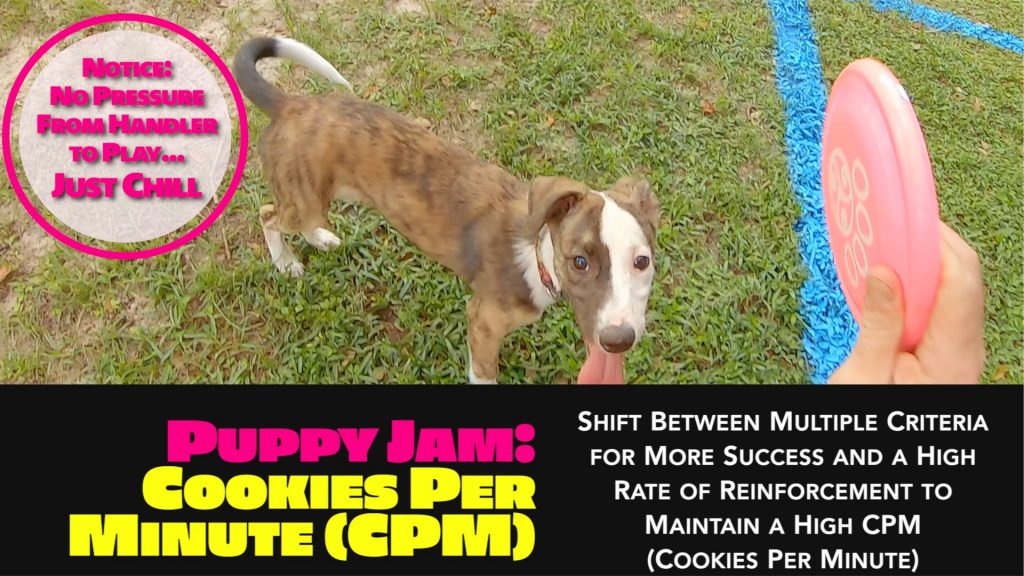
Puppy’s First Disc Dog Jam | Zappa the GrassHoppa
Zappa is a 17 week old puppy who has never played disc. This is a typical introductory puppy training session for us, meaning it is anything but typical. The concepts used are all standard: Working off the Drop, Attention for Next"Next" encapsulates the dog's anticipation of a forthcoming reward, sparking motivation and excitement. This expectancy creates a driving force that propels the dog through training, forming a continuous loop of engagement. When "Next"... More, ShapingShaping is a learning technique where successive approximation and a Positive Marker are used to teach behaviors and communicate concepts. Successive approximation essentially means continually closer to the target behavior. So Shaping is... More Engagement, and Reinforcing with Action, but the application of them is based upon what the puppy gives and what the situation demands. Be sure to catch the voiceover or it won’t make much sense… I’ll lay out some more stuff below.
What the…
When I posted this video at first, Apryl gave me a hard time because she thought nobody would get it. And I get that. There are a lot of things going on here and the situation demanded many shifts in criteria and focus. So I whipped up the voiceover to try to make sense of this wackiness.
There is really only 1 goal in this session: Make playing with the disc a super fun and super exciting operation. As long as that happens, I’m cool.
Many people want to teach the dog from the get go; they want a map to getting and teaching the behaviors. So they focus on criteria for the sake of teaching and getting the skills. This focus sets up a situation where the game of disc, from it’s inception, can be boring a loaded with performance pressure, for both dog and handler.
The reason this session looks wonky to dog trainers is that, while I’m focused on legit criteria like Bite, Drop, Give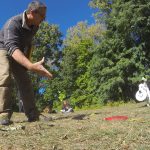 The Give is a retrieve to the hand. A cued Give is a foundational skill that is not super useful in the actual performance of disc dog freestyle, and has huge applications for... More, Attention, and Reorientation, I’m not trying to teach them nor am I trying to get them.
The Give is a retrieve to the hand. A cued Give is a foundational skill that is not super useful in the actual performance of disc dog freestyle, and has huge applications for... More, Attention, and Reorientation, I’m not trying to teach them nor am I trying to get them.
The only focus here is to let him realize that playing with discs is an epic and exciting experience.
Creating and Reinforcing With a Drop Cue
To start off with, Zappa does not have a Drop. He has no clue what “Aus” means. And yet I immediately reinforced with it. How does that work?
Dropping the disc is something that I can bank on. It will happen. It’s 100% a given. Puppies lose focus rather quickly. So I simply give the cue and wait… The repetition and consequent chain plus the marker will make meaning out of the Drop cue rather quickly.
So I give the cue and wait for the teeth to come off as an excuse to fire out another disc.
This often results in a surprised response from the dog, and that’s great when it comes to my ultimate goal – making disc exciting and fun. “OOOOoooh! It’s running away… YAY!”
Leveraging Excitement and Expectation Towards Attention
After a few exciting rollers, markers, and drops, Zappa is in it. He’s digging the game. He doesn’t know how it’s being played or how it’s working, but it’s fun. He’s in it and willing to dedicate a bit of effort to figuring out what’s happening and why.
Once that happens, Attention is a given. I like to leverage the expectation of a cookie after a marker to get Attention. So I cue the Drop, mark the teeth off and wait…
Zappa is expecting something awesome to happen and when it doesn’t he looks to me. Initially I can take some low level, ambient or side eye attention, but I’m going to shape that into good eye contact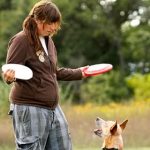 Unsolicited eye contact or Attention is a great way to hook up with a dog. If you have something the dog wants he should give eye contact in order to get access to... More as quickly as I can.
Unsolicited eye contact or Attention is a great way to hook up with a dog. If you have something the dog wants he should give eye contact in order to get access to... More as quickly as I can.
Generating excitement and expectation of excitement is key to reinforcing engagement.
Dealing with Downtime – Be an Opportunity, Not an Obligation
Zappa is not obligated to play with me. He can do whatever he wants. Not badgering the dog to engage is a huge key to engagement. As long as I establish interaction with me and the discs an exciting opportunity, he’s going to hook up with me.
When he checks out, I’m just going to chill. And he is going to check out given his age and the fact that there were cookies all over out there from a previous training session Apryl had with a client, so I’m just waiting for those cookie crumbs to play out and for him to get bored with them.
When he does, I’m going to pounce on interaction with him. This type of management and interaction is free shaping engagement – anything that leads to engagement is fair game – and when I get it, I’m going to reinforce it with a roller, bite, praise, and a pregnant pause if he expects something.
Shaping engagement rather than molding it or insisting that it happens guarantees that I, and the discs, will be looked at as an opportunity, and are far more likely to be taken as a cookie than they would be if I were trying to get him to play disc with me.





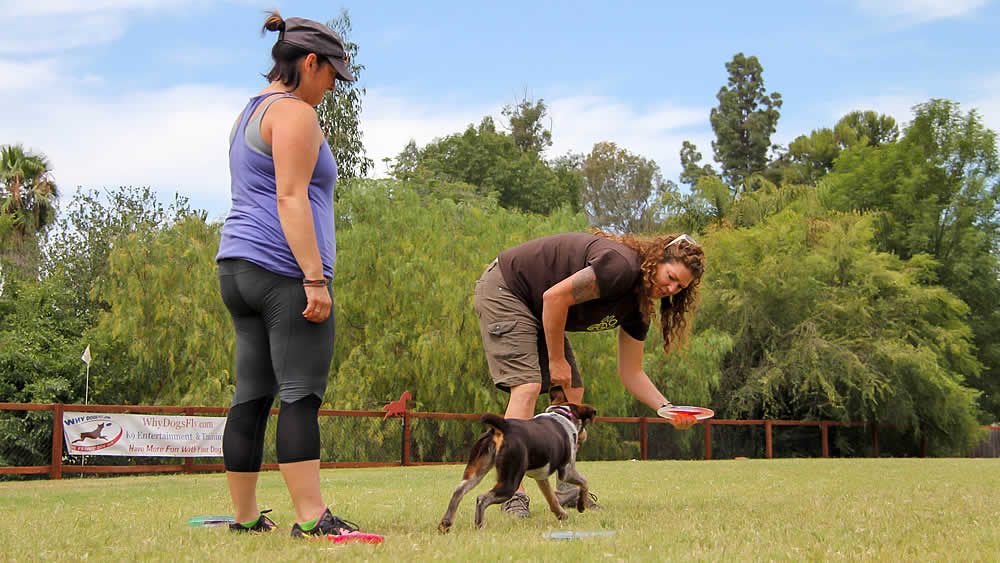
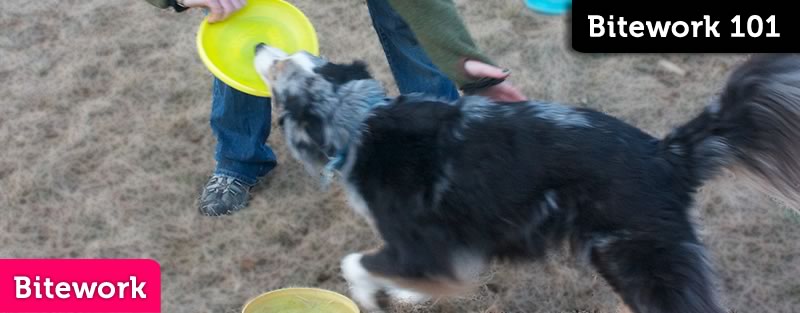
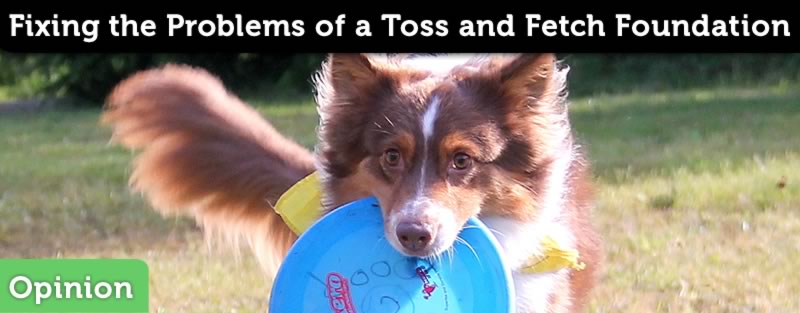
Hi Ron, I recently became a patron. Not sure if I am allowed to ask questions here? but what do I do if in this case the dog chases the disc but doesn”t bring it back but I want to reward them for interacting with it in? TIA , Kelly
You certainly are, Kelly! Please continue to ask questions here. This is a great place.
This is a bit of a loaded question that really depends on what the dog does with the disc out there and where the dog is at in his or her development. I would expect the dog to put some teeth on it if that were possible. If you simply reinforce the dog for chasing you wind up with a dog who thinks it’s cool to do everything but the bite.
That said, if the dog is not so game to engage or chase the disc, reinforcing the chase isn’t a bad idea. You want to shape the bite on the moving target rather quickly. Ideally you reinforce a few reps of pursuit and shape it into the bite.
If the dog bites, at all, go ahead and mark the bite with your drop cue. This will allow you to keep the game moving, much like I was doing with Grasshopper here. It will also fit your bitework play and make the cued Drop an expectation, which means the dog has to catch.
Putting some additional value on the Bite and Drop via bitework would be my focus if I were you… A Quick question: what is your criteria for a successful bite from the hand?
PS – I added you to the credits of DiscDogger Weekly, keep your eyes peeled on the last couple of videos. Your name is in lights! 😉